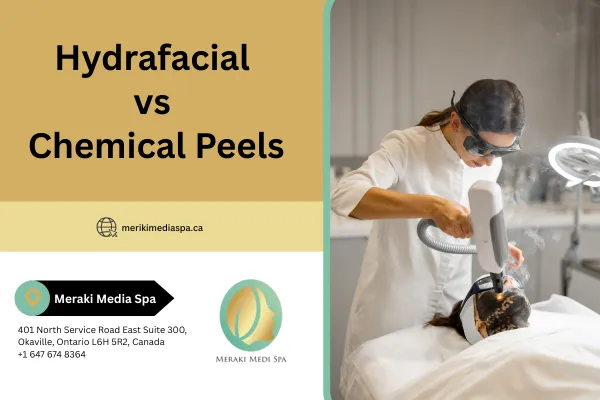
Hydrafacial vs Chemical Peels
Hydrafacials and chemical peels are two of the most talked-about treatments for radiant, healthy skin. Both promise brighter, smoother skin — but they work very differently. So which one is right for you? Let’s explore the differences and benefits so you can make the best choice for your skincare needs.
What Is a Hydrafacial?
A Hydrafacial is a non-invasive facial treatment that combines cleansing, exfoliation, extraction, hydration, and antioxidant protection. It uses vortex-fusion technology to remove impurities while delivering nourishing serums deep into the skin.
This treatment is gentle, relaxing, and safe for all skin types — even sensitive skin. If you’re looking for an immediate glow, improved hydration, and a smoother texture without any downtime, a Hydrafacial is an excellent option.
What Is a Chemical Peel?
A chemical peel involves applying a chemical solution (like glycolic acid, salicylic acid, or TCA) to exfoliate the top layers of the skin. As the skin peels, it reveals newer, healthier skin underneath. Chemical peels can target various skin concerns, including acne scars, sun damage, pigmentation, and fine lines.
Depending on the strength and type of peel, you may experience some redness, tingling, or peeling for a few days afterward. The results are more gradual than those of a hydrafacial but can have more profound, longer-term effects on skin texture and tone.
So, What’s the Difference?
The main difference is intensity and results. Hydrafacials offer immediate results with no downtime, making them ideal for a quick refresh before a special event. They’re gentle and soothing and work well for ongoing maintenance.
Chemical peels, on the other hand, are more intensive. They remove more layers of dead skin and are better suited for treating deeper skin concerns like acne scars, melasma, and sunspots. Depending on the depth of the peel, they may require some downtime, but the results can be more dramatic over time.
Hydrafacials are perfect if you want a fast glow and hydration boost. Chemical peels are better if you’re dealing with long-term skin issues and are okay with a bit of recovery time.
How Much Do They Cost?
Hydrafacials generally cost $150 to $250 per session, while chemical peels, depending on the type and strength, can cost from $100 to $300. Your provider can recommend the best option based on your skin type, budget, and goals.
Which One Should You Choose?
It depends on your individual skin needs and lifestyle.
👉 Choose Hydrafacial if you want an instant glow, hydration, and no recovery time.
👉 Choose Chemical Peel if you’re targeting pigmentation, fine lines, or uneven skin tone and can manage a short healing period.
Final Thoughts
Both treatments have their place in a well-rounded skincare plan. Whether prepping for a big event or tackling deeper skin concerns, consulting with a skincare expert can help you choose the right path to glowing, beautiful skin.
If you're in Oakville and ready to take your skincare to the next level. In that case, Meraki Media Spa offers personalized consultations and professional treatments to help you look and feel your best.
📍 Meraki Media Spa
401 North Service Road East Suite 300, Oakville, ON
🌐 merakimediaspa.ca | 📞 +1 647-674-8364
